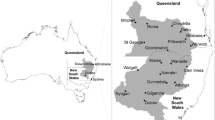Abstract
Similar to forestry, weather and climate related risks in agroforestry may broadly be arranged in three types of risks viz., instant risk, creeping risk and cumulative risk (see Sect. III.4.5.(β)) Interactions in agroforestry systems take place mainly via microclimate, sharing of soil and sharing of soil resources. Agroforestry has a particular potential to help check or reverse degradation of soil, forest and pasture resources. Agroforestry systems could be designed to suit virtually any set of environmental conditions in the tropics and subtropics. The greatest potential contribution that particularly indigenous agroforestry makes is through tree management in densely populated steep lands (Young 1987; Tiffen et al. 1994). Kusumandari and Mitchell (1997) concluded from a model based study that agroforestry was an optimal land use to minimize soil loss.
Access this chapter
Tax calculation will be finalised at checkout
Purchases are for personal use only
Preview
Unable to display preview. Download preview PDF.
Similar content being viewed by others
References
Allen RG, Pereira LS, Raes D, Smith M (1998) Evapotranspiration – guidelines for computing crop water requirements. Irrigation and Drainage Paper 56, FAO, Rome. http://www.fao.org/docrep
Hamilton LS (1986) Towards clarifying the appropriate mandate in forestry for watershed rehabilitation and management. In: Strategies, approaches and systems in integrated watershed management. FAO Conservation Guide 14, Rome. http://www.fao.org/DOCREP/006/AD085E/AD085e06.htm
Kusumandari A, Mitchell B (1997) Soil erosion and sediment yield in forest and agroforestry areas in West Java, Indonesia. J Soil Water Conserv 52:376–380
Stigter CJ, Onyewotu LOZ, Al-Amin NKN (2005) Wind and agriculture; an essential subject of the African Participatory Research Agenda. Paper #103. In: Naprstek J, Fischer C (eds) Proceedings of the 4th European & African Conference on Wind Engineering, ITAMAS, Prague, 11pp
Tiffen M, Mortimore M, Gichuki F (1994) More people, less erosion. Environmental recovery in Kenya. Wiley, New York, 311pp
Warrillow MP (1999) Ecological impact of glaze storm damage in an Appalachian oak forest. M.Sc. thesis submitted to Virginia Polytechnic Institute and State University. www.scholar.lib.vt.edu/theses/available/etd-031999-145749/unrestricted/etd.PDF
Wilkinson KM, Elevitch CR (2000) Multipurpose windbreaks: design and species for Pacific islands. Agroforestry Guides for Pacific Islands 8, 32pp. http://www.agroforestry.net/pubs/multwind.pdf
Wisse JA, Stigter, K (2007) Wind Engineering in Africa. J Wind Eng Indust Aerodyn 95:908–927
Young A (1989) The environmental basis of agroforestry. In: Reifsnyder WS, Darnhofer TO (eds) Meteorology and agroforestry. Proceedings of an International Workshop on The Application of Meteorology to Agroforestry Systems Planning and Management, ICRAF, Nairobi, 9–13 February 1987, pp 29–48
Zomer RJ, Bossio DA, Trabucco A, Li Yuanjie, Gupta DC, Singh VP (2007) Trees and water: smallholder agroforestry on irrigated lands in Northern India. IWMI Research Report 122. International Water Management Institute, Colombo, Sri Lanka, 47pp. http://www.iwmi.cgiar.org/Publications/IWMI_Research_Reports/PDF/PUB122/RR122.pdf
Author information
Authors and Affiliations
Corresponding author
Editor information
Editors and Affiliations
Rights and permissions
Copyright information
© 2010 Springer-Verlag Berlin Heidelberg
About this chapter
Cite this chapter
Stigter, K., Ramesh, K. (2010). Developing Scales and Tools for Weather and Climate Related Risk Quantifications in Agroforestry. In: Stigter, K. (eds) Applied Agrometeorology. Springer, Berlin, Heidelberg. https://doi.org/10.1007/978-3-540-74698-0_83
Download citation
DOI: https://doi.org/10.1007/978-3-540-74698-0_83
Published:
Publisher Name: Springer, Berlin, Heidelberg
Print ISBN: 978-3-540-74697-3
Online ISBN: 978-3-540-74698-0
eBook Packages: Earth and Environmental ScienceEarth and Environmental Science (R0)




